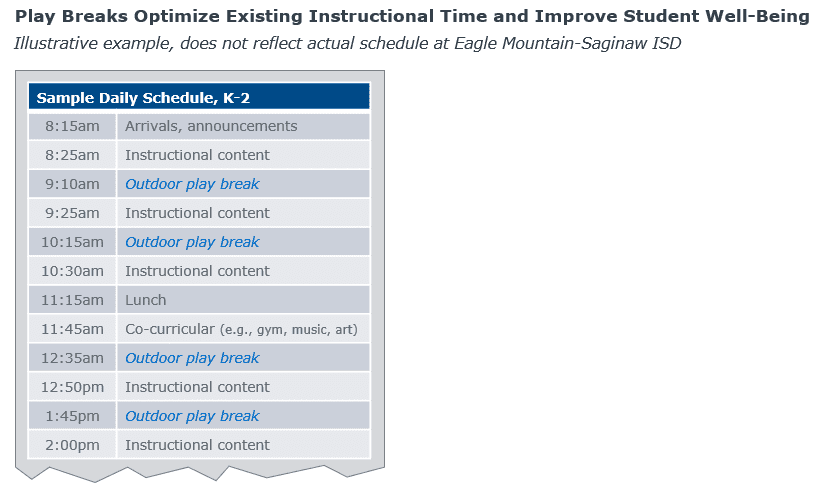Time to play: Increasing daily recess in elementary schools
With so many competing priorities, it becomes easy for educators to intentionally or unintentionally cut recess to focus on academic instruction. However, research is clear on the developmental need for young children to play. Unstructured outdoor recess provides kids with an outlet to take a mental break from learning and to exercise and expend energy, which ultimately enhances focus during instruction.
Perhaps more importantly, children also learn critical social, emotional, and cognitive skills through play with their peers. Unstructured play is one of the most valuable ways that young children learn and practice skills such as problem solving, creativity, emotional and behavioral regulation, collaboration, perspective taking, and compromise.
However, since 2001 average weekly recess time in U.S. schools has declined by 60 minutes. Not only do elementary students now get an average of just 25 minutes of recess per day, but over 75% of school districts do not have a formal policy requiring daily recess for their youngest learners. Recess provision is typically left to individual school and even teacher discretion, which often results in its use as a discipline tool. Recess is frequently withheld or shortened as punishment for bad behavior or given as a reward, but unstructured play time is rarely seen as necessary component of supporting student learning and social-emotional development.
Key Insights
75%
of school districts don’t have a formal policy requiring daily recess for their youngest learners30
minutes per day was the starting district-wide policy at Eagle Mountain-Saginaw ISDBringing implementation to life
For Eagle Mountain-Saginaw Independent School District (ISD) in Fort Worth, Texas, partnering with the LiiNK Project has helped district leaders systematically set and reinforce the expectation that daily unstructured play is a universal social-emotional support for all elementary school students.
Prior to implementing LiiNK, the district had taken small steps to increase recess for students by adding five minutes to the school day overall and putting a district-wide policy in place increasing elementary-level recess to 30 minutes per day. After learning about the LiiNK Project, administrators realized the district could do even more to support students’ social-emotional health.
Eagle Mountain-Saginaw ISD began partnering with LiiNK in 2014, starting with two pilot elementary schools implementing in kindergarten and first grade. After securing proof of concept, the district included more school sites and grade levels. Each year, three to four new schools start LiiNK in kindergarten and first grade while current adopters add one additional grade level.
The goal in Eagle Mountain-Saginaw ISD is to have all elementary schools, grades K-5 implement the LiiNK Project, with 11 of 15 elementary schools already going through the process. Most importantly, after restructuring the daily schedule and increasing unstructured play time to an hour a day, administrators have not seen any negative impact on LiiNK students’ academic performance.
Helping teachers embrace the value of play
Fears around losing instructional time can pose a barrier to staff buy-in, making training and implementation support critically important. LiiNK Project facilitators lead a three-day training on the research base behind the developmental benefits of unstructured play and how play breaks maximize instructional time. Administrators then support school leaders in carefully planning the new daily schedule to balance instruction with the added play breaks and character education lessons.

How instructional time is adjusted to accommodate the play breaks will depend heavily on individual district context and may vary in each grade level. The schedule development process focuses on ensuring teachers have their lessons and daily activities well-planned, and on reducing transition time between each lesson and activity.
Ultimately, teachers at LiiNK schools report spending less time redirecting behavior and re-teaching content as students get the mental and physical breaks needed to learn effectively.
More Blogs

From building managers to strategic leaders

From cell phones to STEM: What district leaders are focused on right now

Is your district adequately preparing students for a future with AI?
Great to see you today! What can I do for you?